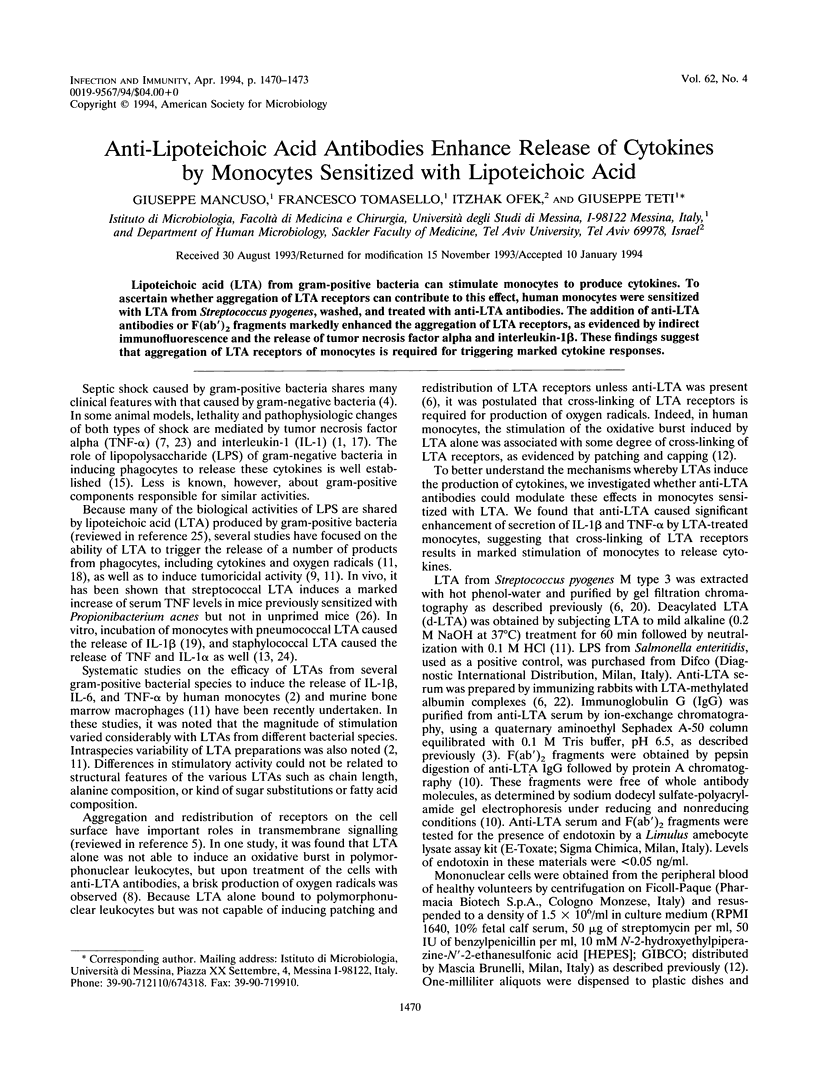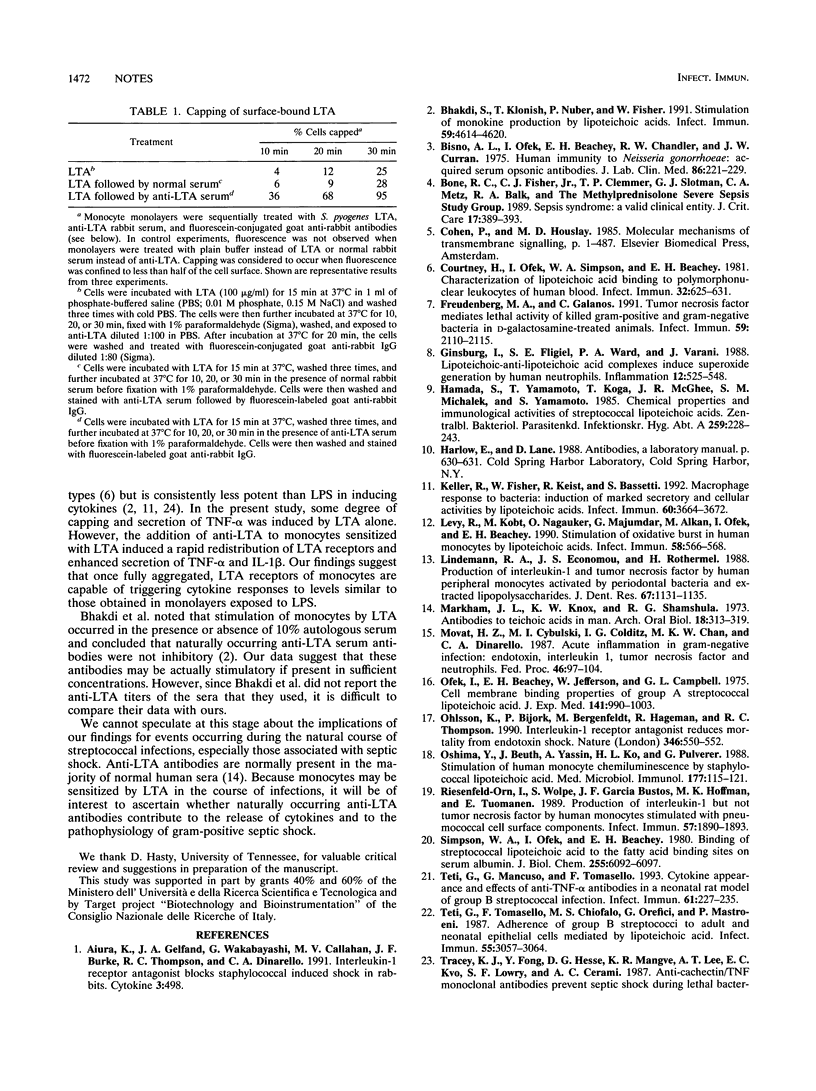Abstract
Lipoteichoic acid (LTA) from gram-positive bacteria can stimulate monocytes to produce cytokines. To ascertain whether aggregation of LTA receptors can contribute to this effect, human monocytes were sensitized with LTA from Streptococcus pyogenes, washed, and treated with anti-LTA antibodies. The addition of anti-LTA antibodies or F(ab')2 fragments markedly enhanced the aggregation of LTA receptors, as evidenced by indirect immunofluorescence and the release of tumor necrosis factor alpha and interleukin-1 beta. These findings suggest that aggregation of LTA receptors of monocytes is required for triggering marked cytokine responses.
Full text
PDF



Selected References
These references are in PubMed. This may not be the complete list of references from this article.
- Bhakdi S., Klonisch T., Nuber P., Fischer W. Stimulation of monokine production by lipoteichoic acids. Infect Immun. 1991 Dec;59(12):4614–4620. doi: 10.1128/iai.59.12.4614-4620.1991. [DOI] [PMC free article] [PubMed] [Google Scholar]
- Bisno A. L., Ofek I., Beachey E. H., Chandler R. W., Curran J. W. Human immunity to Neisseria gonorrhoeae: acquired serum opsonic antibodies. J Lab Clin Med. 1975 Aug;86(2):221–229. [PubMed] [Google Scholar]
- Bone R. C., Fisher C. J., Jr, Clemmer T. P., Slotman G. J., Metz C. A., Balk R. A. Sepsis syndrome: a valid clinical entity. Methylprednisolone Severe Sepsis Study Group. Crit Care Med. 1989 May;17(5):389–393. [PubMed] [Google Scholar]
- Courtney H., Ofek I., Simpson W. A., Beachey E. H. Characterization of lipoteichoic acid binding to polymorphonuclear leukocytes of human blood. Infect Immun. 1981 May;32(2):625–631. doi: 10.1128/iai.32.2.625-631.1981. [DOI] [PMC free article] [PubMed] [Google Scholar]
- Freudenberg M. A., Galanos C. Tumor necrosis factor alpha mediates lethal activity of killed gram-negative and gram-positive bacteria in D-galactosamine-treated mice. Infect Immun. 1991 Jun;59(6):2110–2115. doi: 10.1128/iai.59.6.2110-2115.1991. [DOI] [PMC free article] [PubMed] [Google Scholar]
- Ginsburg I., Fligiel S. E., Ward P. A., Varani J. Lipoteichoic acid-antilipoteichoic acid complexes induce superoxide generation by human neutrophils. Inflammation. 1988 Dec;12(6):525–548. doi: 10.1007/BF00914316. [DOI] [PubMed] [Google Scholar]
- Hamada S., Yamamoto T., Koga T., McGhee J. R., Michalek S. M., Yamamoto S. Chemical properties and immunobiological activities of streptococcal lipoteichoic acids. Zentralbl Bakteriol Mikrobiol Hyg A. 1985 Apr;259(2):228–243. doi: 10.1016/s0176-6724(85)80054-7. [DOI] [PubMed] [Google Scholar]
- Keller R., Fischer W., Keist R., Bassetti S. Macrophage response to bacteria: induction of marked secretory and cellular activities by lipoteichoic acids. Infect Immun. 1992 Sep;60(9):3664–3672. doi: 10.1128/iai.60.9.3664-3672.1992. [DOI] [PMC free article] [PubMed] [Google Scholar]
- Levy R., Kotb M., Nagauker O., Majumdar G., Alkan M., Ofek I., Beachey E. H. Stimulation of oxidative burst in human monocytes by lipoteichoic acids. Infect Immun. 1990 Feb;58(2):566–568. doi: 10.1128/iai.58.2.566-568.1990. [DOI] [PMC free article] [PubMed] [Google Scholar]
- Lindemann R. A., Economou J. S., Rothermel H. Production of interleukin-1 and tumor necrosis factor by human peripheral monocytes activated by periodontal bacteria and extracted lipopolysaccharides. J Dent Res. 1988 Aug;67(8):1131–1135. doi: 10.1177/00220345880670081401. [DOI] [PubMed] [Google Scholar]
- Markham J. L., Knox K. W., Schamschula R. G., Wicken A. J. Antibodies to teichoic acids in man. Arch Oral Biol. 1973 Mar;18(3):313–319. doi: 10.1016/0003-9969(73)90153-2. [DOI] [PubMed] [Google Scholar]
- Movat H. Z., Cybulsky M. I., Colditz I. G., Chan M. K., Dinarello C. A. Acute inflammation in gram-negative infection: endotoxin, interleukin 1, tumor necrosis factor, and neutrophils. Fed Proc. 1987 Jan;46(1):97–104. [PubMed] [Google Scholar]
- Ofek I., Beachey E. H., Jefferson W., Campbell G. L. Cell membrane-binding properties of group A streptococcal lipoteichoic acid. J Exp Med. 1975 May 1;141(5):990–1003. doi: 10.1084/jem.141.5.990. [DOI] [PMC free article] [PubMed] [Google Scholar]
- Ohlsson K., Björk P., Bergenfeldt M., Hageman R., Thompson R. C. Interleukin-1 receptor antagonist reduces mortality from endotoxin shock. Nature. 1990 Dec 6;348(6301):550–552. doi: 10.1038/348550a0. [DOI] [PubMed] [Google Scholar]
- Ohshima Y., Beuth J., Yassin A., Ko H. L., Pulverer G. Stimulation of human monocyte chemiluminescence by staphylococcal lipoteichoic acid. Med Microbiol Immunol. 1988;177(3):115–121. doi: 10.1007/BF00232891. [DOI] [PubMed] [Google Scholar]
- Riesenfeld-Orn I., Wolpe S., Garcia-Bustos J. F., Hoffmann M. K., Tuomanen E. Production of interleukin-1 but not tumor necrosis factor by human monocytes stimulated with pneumococcal cell surface components. Infect Immun. 1989 Jul;57(7):1890–1893. doi: 10.1128/iai.57.7.1890-1893.1989. [DOI] [PMC free article] [PubMed] [Google Scholar]
- Simpson W. A., Ofek I., Beachey E. H. Binding of streptococcal lipoteichoic acid to the fatty acid binding sites on serum albumin. J Biol Chem. 1980 Jul 10;255(13):6092–6097. [PubMed] [Google Scholar]
- Teti G., Mancuso G., Tomasello F. Cytokine appearance and effects of anti-tumor necrosis factor alpha antibodies in a neonatal rat model of group B streptococcal infection. Infect Immun. 1993 Jan;61(1):227–235. doi: 10.1128/iai.61.1.227-235.1993. [DOI] [PMC free article] [PubMed] [Google Scholar]
- Teti G., Tomasello F., Chiofalo M. S., Orefici G., Mastroeni P. Adherence of group B streptococci to adult and neonatal epithelial cells mediated by lipoteichoic acid. Infect Immun. 1987 Dec;55(12):3057–3064. doi: 10.1128/iai.55.12.3057-3064.1987. [DOI] [PMC free article] [PubMed] [Google Scholar]
- Tracey K. J., Fong Y., Hesse D. G., Manogue K. R., Lee A. T., Kuo G. C., Lowry S. F., Cerami A. Anti-cachectin/TNF monoclonal antibodies prevent septic shock during lethal bacteraemia. Nature. 1987 Dec 17;330(6149):662–664. doi: 10.1038/330662a0. [DOI] [PubMed] [Google Scholar]
- Wakabayashi G., Gelfand J. A., Jung W. K., Connolly R. J., Burke J. F., Dinarello C. A. Staphylococcus epidermidis induces complement activation, tumor necrosis factor and interleukin-1, a shock-like state and tissue injury in rabbits without endotoxemia. Comparison to Escherichia coli. J Clin Invest. 1991 Jun;87(6):1925–1935. doi: 10.1172/JCI115218. [DOI] [PMC free article] [PubMed] [Google Scholar]
- Yamamoto A., Usami H., Nagamuta M., Sugawara Y., Hamada S., Yamamoto T., Kato K., Kokeguchi S., Kotani S. The use of lipoteichoic acid (LTA) from Streptococcus pyogenes to induce a serum factor causing tumour necrosis. Br J Cancer. 1985 May;51(5):739–742. doi: 10.1038/bjc.1985.112. [DOI] [PMC free article] [PubMed] [Google Scholar]


